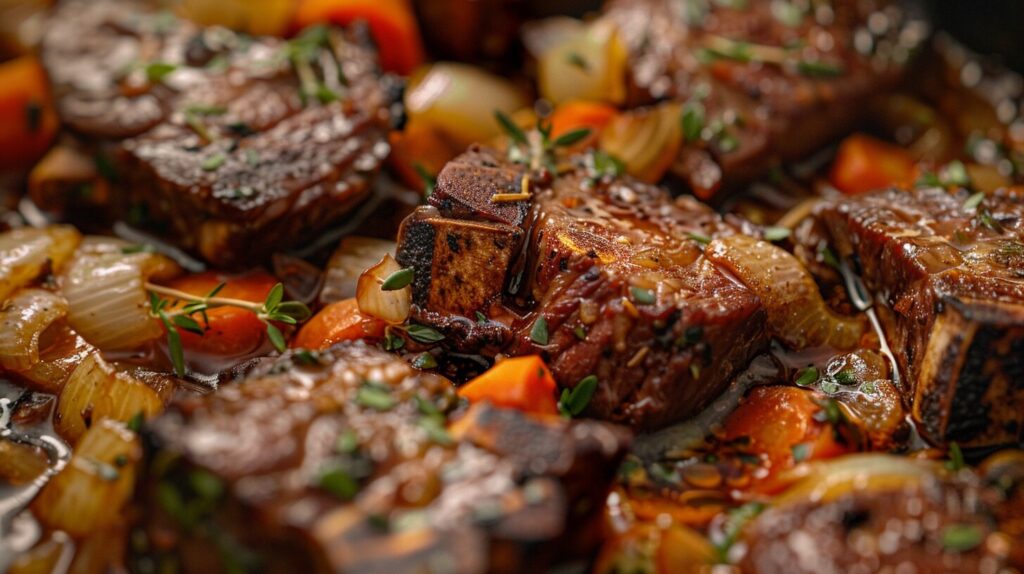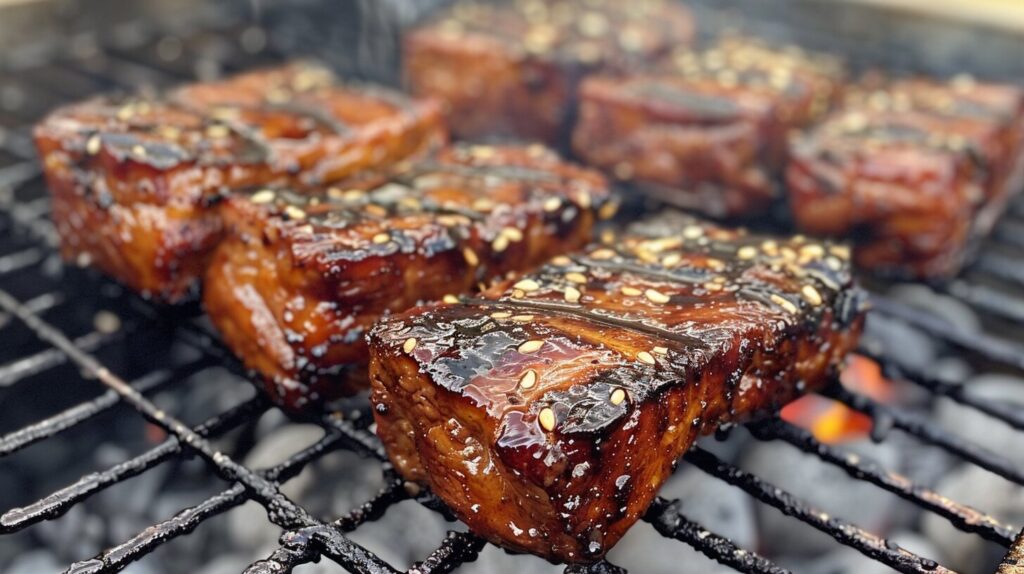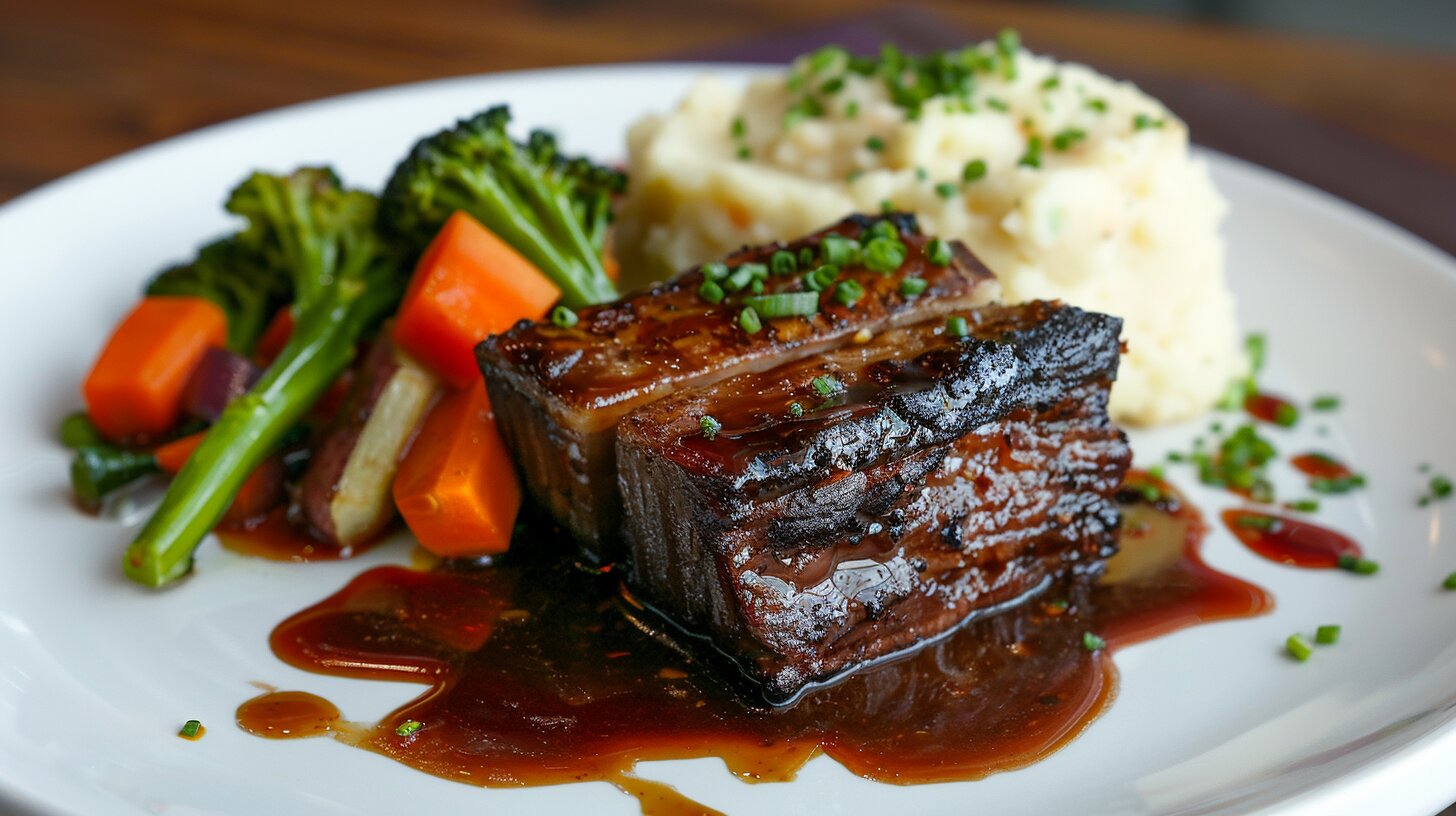Table of Contents
Boneless short ribs are a versatile and flavorful cut of beef that can be the star of any meal. Known for their rich marbling and succulent texture, these ribs are perfect for comfort food dishes and gourmet presentations. However, selecting the proper cooking method for boneless short ribs is crucial to achieving the perfect balance of tenderness and flavor.
This guide will explore the best ways to cook boneless short ribs, from braising to grilling. Whether you’re a seasoned chef or a home cook, this article will provide all the tips and techniques you need to master this delectable cut of beef.
What Are Boneless Short Ribs?
Boneless short ribs are a prized cut of beef derived from the chuck or plate section of the cow. Unlike traditional bone-in short ribs, these are meatier and contain no bones, making them more convenient to prepare and eat. Choosing the proper cooking method for boneless short ribs enhances their intense marbling and rich, beefy flavor. This cut becomes tender and flavorful when appropriately cooked using a preferred cooking method for boneless short ribs, making it a favorite among chefs and home cooks.
While the name may suggest a similarity to classic ribs, boneless short ribs are more akin to a tender steak, offering a delightful chew and a robust taste. Their versatility makes them ideal for various cooking techniques, from slow braising to quick grilling.
Flavor Profile and Texture
The flavor of boneless short ribs is deeply satisfying, offering a savory, melt-in-your-mouth quality when cooked low and slow. But if cooked improperly, they can turn tough and chewy. This is due to the connective tissues and collagen that require careful attention to break down properly during cooking.
Common Culinary Uses
Boneless short ribs are often used in dishes such as:
- Braised Ribs: Slowly cooked in a flavorful liquid to achieve tender, fall-apart meat.
- Korean-style barbecue: Marinated and grilled for a smoky and sweet flavor.
- Beef Stews: Adding richness to hearty stews with their tender texture and bold taste.
Why the Cooking Method Matters
Cooking boneless short ribs is all about balancing tenderness and flavor. Because this cut contains high fat and connective tissue, the method you choose will determine whether the meat is tough or succulent.
Tenderizing Connective Tissue
Boneless short ribs are loaded with collagen, which requires slow, moist cooking to transform into gelatin, which gives the meat its signature tenderness. Methods like braising or slow cooking are ideal for breaking down these tissues.
Maximizing Flavor
Each cooking method unlocks different aspects of flavor:
- Grilling emphasizes the charred, smoky essence.
- Braising infuses the beef with the savory richness of the cooking liquid.
- Sous Vide allows for precision, ensuring a perfectly cooked interior.
Matching Cooking Methods to Occasion
Choosing the proper cooking method also depends on your time and occasion:
- Braising or Slow Cooking: Perfect for family dinners or make-ahead meals.
- Grilling: Great for outdoor gatherings.
- Sous Vide: Ideal for impressing guests with precision cooking.
When you understand the unique characteristics of boneless short ribs, you can select the cooking technique that best suits your recipe and ensures the most delicious result.
Best Cooking Methods for Boneless Short Ribs
Boneless short ribs are incredibly versatile and can be prepared using several methods. Below are the most popular techniques to help you make the most of this flavorful cut.
Braising: The Gold Standard for Tender Ribs

Braising is a classic method for cooking boneless short ribs, and for good reason—it delivers fall-apart tenderness and rich flavor. This slow-cooking technique simmers the meat in a flavorful liquid for hours, allowing the collagen and fat to break into a luscious texture.
Step-by-Step Guide to Braising:
- Preparation: Season the ribs generously with salt, pepper, or a dry rub.
- Searing: Heat oil in a heavy skillet or Dutch Oven and sear the ribs on all sides until browned.
- Deglazing: Remove the ribs and deglaze the pan with wine, broth, or your preferred liquid, scraping up the flavorful browned bits.
- Simmering: Add aromatics like onions, garlic, and herbs, then return the ribs to the pot. Pour enough liquid (broth, wine, or a combination) to cover them halfway.
- Cooking: Cover and simmer on low heat for 2-3 hours, or transfer to a 325°F (165°C) Oven. Check periodically to ensure the liquid doesn’t evaporate completely.
Popular Braising Variations:
- Red Wine Braised Short Ribs: Uses red wine, beef broth, rosemary, and thyme for a gourmet twist.
- Asian-Style Braising: Features soy sauce, ginger, and star anise for a rich, umami-packed dish.
- Tomato-Based Braising: Incorporates tomatoes and Italian herbs for a Mediterranean vibe.
Slow Cooking: Effortless Perfection
The slow cooker is a hands-off option for tender, boneless short ribs. You can replicate the effects of braising without constant attention by cooking the meat over low heat for several hours.
How to Slow Cook Boneless Short Ribs:
- Prepare the Ribs: Season the ribs and optionally sear them for added flavor.
- Layer Ingredients: Place the ribs in the slow cooker with vegetables like carrots and celery.
- Add Liquid: Pour in broth, wine, or sauce to provide moisture.
- Cook Low and Slow: Set the cooker to low and cook for 6-8 hours or on high for 4-5 hours.
Benefits of Slow Cooking:
- Minimal effort is required.
- Perfect for busy days.
- Excellent for meal prep or make-ahead dishes.
Grilling: Smoky and Charred Goodness

Grilling is an excellent option for adding a smoky flavor to boneless short ribs. While this method doesn’t deliver the same tenderness as braising or slow cooking, it creates a flavorful crust that’s hard to resist.
Tips for Grilling Boneless Short Ribs:
- Marinate: To add moisture and flavor, marinate the ribs for at least 2-4 hours in a mix of oil, vinegar, soy sauce, and spices.
- Pre-Cook (Optional): Consider briefly braising or parboiling the ribs before grilling to ensure tenderness.
- Direct and Indirect Heat: Grill the ribs over high heat for a few minutes to create a crust, then move them to indirect heat to cook through.
- Baste Frequently: Brush the ribs with barbecue sauce or glaze during grilling for added flavor.
Perfect Pairing: Grilled short ribs shine with tangy barbecue sauces, slaws, or roasted vegetables.
Oven Roasting: A Reliable and Flavorful Option
Oven roasting is a straightforward method for preparing boneless short ribs, balancing tenderness and convenience. While it may not achieve the same melt-in-your-mouth texture as braising, oven roasting can produce flavorful, caramelized results.
How to Roast Boneless Short Ribs in the Oven:
- Pre-heat the Oven to 350 degrees. Set the oven at 350 degF (175degC).
- Season the Ribs: Apply a dry rub or seasoning blend, ensuring an even coat.
- Sear for Flavor (Optional): Sear the ribs on all sides in a hot skillet to develop a crust.
- Add Moisture: Place the ribs in a roasting pan and add a small amount of liquid, such as beef broth, wine, or sauce, to keep the meat moist.
- Cover and Cook: Cover the pan with foil and roast for 2-3 hours, checking periodically to ensure the liquid hasn’t evaporated.
- Uncover for the Final Touch: Remove the foil in the last 20-30 minutes to allow the ribs to develop a caramelized crust.
Advantages of Oven Roasting:
- Great for large batches.
- Easy to customize with sauces and rubs.
- Yields a crusty exterior with a tender interior.
Popular Flavor Variations:
- Honey Mustard Glaze: Combine honey, Dijon mustard, and garlic for a sweet and tangy coating.
- Smoky Paprika Rub: Blend paprika, garlic powder, and cayenne for a smoky, spicy flavor.
- Herb-Crusted Ribs: Use rosemary, thyme, and parsley for a fresh, aromatic profile.
Sous Vide: Precision Cooking for Unmatched Tenderness
Sous vide is the ultimate cooking method for boneless short ribs. By vacuum-sealing the meat and cooking it in a water bath at a precise temperature, you can achieve perfectly cooked short ribs with unparalleled control over texture and flavor.
Step-by-Step Guide to Sous Vide Short Ribs:
- Season and Seal: Season the ribs with salt, pepper, or a rub, then vacuum-seal them in a food-grade plastic bag.
- Set the Temperature: For tender and juicy ribs, set your sous vide device to 135°F (57°C) for medium-rare or 165°F (74°C) for a more traditional braised texture.
- Cook Low and Slow: Place the sealed bag in the water bath and cook for 24-48 hours, depending on your desired tenderness.
- Sear Before Serving: After sous vide cooking, remove the ribs from the bag, pat them dry, and quickly sear them in a hot skillet or grill for added flavor.
Why Sous Vide is a Game-Changer:
- Ensures consistent doneness from edge to edge.
- Keeps the juices and the flavors of the animal.
- Allows for precise control over texture and tenderness.
Pro Tip: After sous vide cooking, glaze the ribs with barbecue sauce or reduce the cooking juices for a gourmet finish.
Choosing the Right Method for You
Each of these cooking methods offers unique advantages:
- Oven roasting is ideal for a quick, flavorful result.
- Sous vide is perfect for achieving restaurant-quality tenderness.
- Your choice will depend on your available time, tools, and desired outcome.
Tips for Enhancing Flavor
Boneless short ribs are naturally rich and flavorful, but choosing the proper cooking method for boneless short ribs can elevate their taste to a whole new level. Here are some tips to ensure your short ribs turn out tender, juicy, and bursting with flavor:
Use Marinades for Extra Depth
Marinating your short ribs enhances their flavor and helps tenderize the meat. A good marinade combines acid, oil, and seasoning to create a balanced profile.
Marinade Suggestions:
- Asian-Style Marinade: Soy sauce, sesame oil, garlic, ginger, and brown sugar.
- Herb-Infused Marinade: Olive oil, lemon juice, rosemary, thyme, and garlic.
- Smoky Barbecue Marinade: Worcestershire sauce, liquid smoke, paprika, and molasses.
Tips for Marinating:
- Let the ribs soak for at least 4-6 hours or overnight for maximum impact.
- Always place the marinade at room temperature to avoid the growth of bacteria.
- Pat the ribs dry before cooking to ensure a proper sear.
Dry Rubs for a Crusty Exterior
Dry rubs are an excellent alternative to marinades, especially if you prefer a crispy, caramelized exterior. They form a flavorful crust during grilling, roasting, or searing.
Classic Dry Rub Ingredients:
- Brown sugar (for sweetness and caramelization)
- Paprika (for a smoky flavor)
- Garlic powder and onion powder
- Cayenne or chili powder (for a kick)
- Salt and black pepper (for balance)
Rub the mixture generously over the ribs, ensuring even coverage. Let the meat rest for 1-2 hours before cooking to allow the flavors to penetrate.
Incorporate Aromatics and Liquids
Adding aromatics and liquids can infuse your short ribs with additional layers of flavor during cooking.
Aromatic Ingredients:
- Garlic, onions, and shallots
- Fresh herbs like thyme, rosemary, and bay leaves
- Whole spices like star anise, cinnamon, or cloves
Flavorful Liquids for Cooking:
- Beef or chicken stock
- Red wine or beer
- Soy sauce or Worcestershire sauce
Basting and Glazing
Basting the ribs during cooking ensures they remain moist and flavorful. For grilled or roasted ribs, apply a glaze or sauce in the final stages of cooking to prevent burning.
Popular Glaze Options:
- Honey Garlic Glaze: Mix honey, garlic, soy sauce, and a touch of vinegar.
- Tangy Barbecue Sauce: Combine ketchup, brown sugar, vinegar, and smoked paprika.
- Spicy Korean Gochujang Glaze: Blend gochujang paste, sesame oil, and sugar for a sweet-spicy kick.
Common Mistakes to Avoid
Avoiding common pitfalls will help you achieve the best results when cooking boneless short ribs.
Mistake 1: Overcooking or Undercooking
- Overcooking leads to dry, tough meat, especially when using high-heat methods like grilling.
- Undercooking: Leaves the connective tissues intact, resulting in a chewy texture.
Solution: Follow recommended cooking times and use a meat thermometer to ensure doneness. Aim for an internal temperature of around 190°F (88°C) for braised or slow-cooked ribs and 135°F (57°C) for sous vide ribs.
Mistake 2: Skipping the Sear
Skipping the searing step can result in a lack of depth in flavor. The Maillard reaction occurs during searing, creating a rich, caramelized crust that enhances the overall taste.
Solution: Always sear your ribs before slow cooking or braising for added flavor.
Mistake 3: Neglecting Moisture
Cooking boneless short ribs without enough liquid or fat can make them dry and unappetizing.
Solution: Always ensure that your cooking method incorporates enough moisture, whether through a marinade, broth, or sauce.
Mistake 4: Not Resting the Meat
Cutting into the ribs immediately after cooking can cause the juices to escape, leaving the meat dry.
Solution: Let the ribs rest 5-10 minutes after cooking to allow the juices to redistribute.
Pairing Suggestions
Boneless short ribs are rich and hearty, making them an ideal centerpiece for a meal. Pairing them with complementary sides, sauces, and beverages will elevate your dining experience.
Best Side Dishes for Boneless Short Ribs
- Mashed Potatoes: Creamy mashed potatoes pair beautifully with the savory flavors of braised or roasted ribs.
- Roasted Vegetables: Caramelized carrots, parsnips, and Brussels sprouts add sweetness and balance.
- Polenta: Creamy or fried polenta is an excellent alternative to traditional starches, adding a subtle buttery flavor.
- Rice Pilaf: Herb-infused rice pilaf absorbs the juices and complements the beefy taste.
- Salads: A crisp, tangy side salad with vinaigrette can cut through the meat’s richness.
Sauces to Enhance the Flavor
- Red Wine Reduction: A rich sauce that reduces red wine, beef stock, and herbs.
- Barbecue Sauce: Smoky, tangy barbecue sauces are perfect for grilled ribs.
- Horseradish Cream: A sharp, creamy sauce that pairs well with oven-roasted ribs.
- Chimichurri: This fresh herb sauce adds a zesty punch, especially for grilled or seared ribs.
Beverage Pairings
- Red Wine: Bold, full-bodied wines like Cabernet Sauvignon or Malbec pair beautifully with the richness of short ribs.
- Beer: Dark beers like stouts or porters complement the caramelized and smoky flavors.
- Whiskey or Bourbon: The sweet, smoky notes in whiskey pair wonderfully with barbecued or grilled ribs.
- Non-Alcoholic Options: Sparkling water with a twist of lime or a rich, spiced apple cider offers a refreshing contrast.
Frequently Asked Questions (FAQ):
1. How long should I cook boneless short ribs?
Cooking times depend on the method:
- Braising or Slow Cooking: 2-3 hours on the stovetop or Oven; 6-8 hours in a slow cooker.
- Grilling: 10-15 minutes, with a pre-cook step for tenderness.
- Sous Vide: 24-48 hours at 135°F-165°F.
2. Should I sear boneless short ribs before cooking?
Yes! Searing seals in the flavor and forms a thick crust. Always sear the ribs before braising, slow cooking, or roasting.
3. Can I cook boneless short ribs from frozen?
Yes, but it’s recommended to thaw them first for even cooking. Adjust the cooking time to ensure the meat is thoroughly tender if cooking from frozen.
4. What is the best way to tenderize boneless short ribs?
Slow, moist cooking methods like braising or slow cooking are the best for breaking down connective tissues and tenderizing the meat.
5. Can I use boneless short ribs for stir-fry or quick cooking?
Yes, but the meat should be sliced thinly against the grain and marinated beforehand to prevent toughness.
6. Are boneless short ribs expensive?
While they can be pricier than other cuts, their flavor and versatility make them a worthwhile investment for special occasions or hearty meals.
Conclusion
Boneless short ribs are a versatile and flavorful cut of beef that can be prepared using various cooking methods for boneless short ribs, from braising to sous vide. Selecting the correct technique ensures that your boneless short ribs turn out tender, juicy, and flavorful. Whether hosting a dinner party or preparing a comforting meal at home, mastering the ideal cooking method for boneless short ribs will make this dish a standout centerpiece.
Experiment with marinades, side dishes, and sauces to find the perfect pairing for your ribs. Avoid common mistakes, such as overcooking boneless beef short ribs or neglecting the sear, to achieve consistently delicious results.
With this guide, you’re on your way to creating restaurant-quality boneless short ribs in your kitchen.
